Honor Award
Townscaping an Automobile-Oriented Fabric: Farmington, Arkansas
Farmington, Arkansas
University of Arkansas Community Design Center, Fayetteville, AR
Client: City of Farmington, Arkansas
 Close Me!
Close Me!The Corridor is Restructured as a Series of Urban Rooms that Calm Traffic and Bear Food
The planning area captures the town's commercial base located south of the highway, opposite public school facilities, a senior citizen community center, city hall, and safety service facilities.
Download Hi-Res ImageImage: University of Arkansas Community Design Center
Image 1 of 16
 Close Me!
Close Me!Farmington was once the World's Orchard
Farmington was once a substantial downtown agricultural processing center in one of the country's largest apple-growing regions. It is estimated that 40 percent of the apples and pears grown at the turn of the 20th century were grown in Northwest Arkansas.
Download Hi-Res ImageImage: University of Arkansas Community Design Center
Image 2 of 16
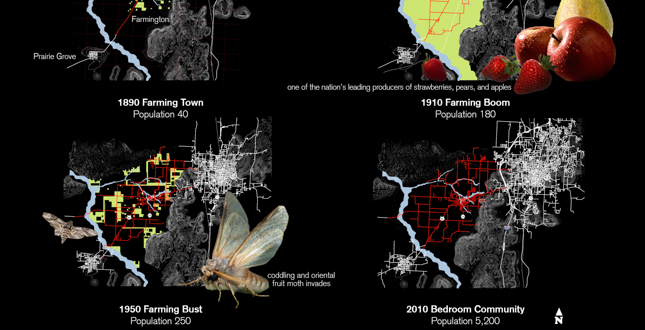 Close Me!
Close Me!The Evolution of Farmington
Mapping analyses chronicle Farmington's changing urban morphology, where it was once a center of agricultural processing. Now, Farmington is a bedroom community to surrounding communities, which have retained their downtown cores.
Download Hi-Res ImageImage: University of Arkansas Community Design Center
Image 3 of 16
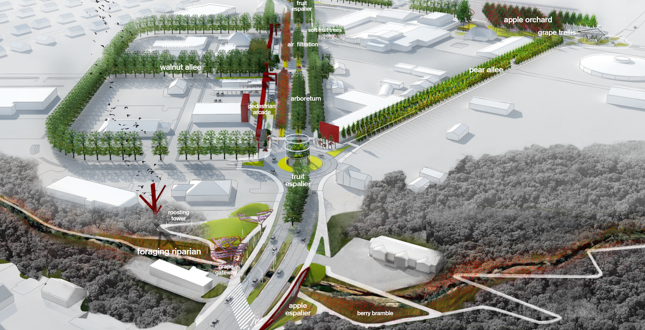 Close Me!
Close Me!Re-establishing a Local Foodscape
The project proposes a “productive” landscape, which functions as a continuous public network integrating urban and ecological systems. Akin to a public utility, the network defines new public spaces, blocks, neighborhood edges, and transitions between the town fabric and its riparian corridor, recalling Farmington's lost agricultural heritage.
Download Hi-Res ImageImage: University of Arkansas Community Design Center
Image 4 of 16
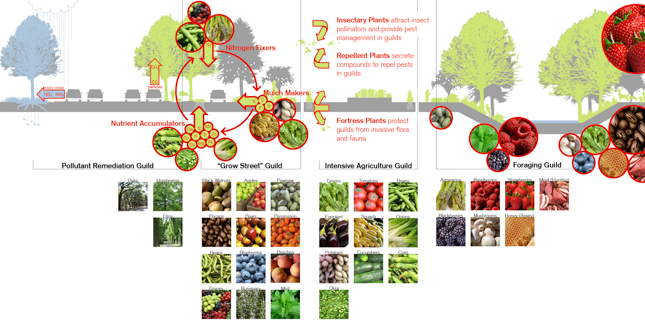 Close Me!
Close Me!Smart Urban Agricultural Interfaces Reclaim a Lost Agricultural Literacy
Urban landscapes are designed as laminated ecosystems since some plants are optimal remediators of air and water pollution, while others favor nutrient cycling and soil husbandry or integrated pest management.
Download Hi-Res ImageImage: University of Arkansas Community Design Center
Image 5 of 16
 Close Me!
Close Me!Phase 3: Accentuate with Landmarks
Triangulate school and commercial zones with traffic roundabouts that replace traffic signals, accompanied by public art with novel urbanized agricultural structures.
Phase 2: Frame with Landscape and New Street Geometries
Connect gateways with new street geometries, incorporating a multiway boulevard, a green access alley, bike and pedestrian trails, and urban agricultural systems.
Phase 1: Bound with Gateways
Demarcate entries into city services complex and commercial strip with town gateways.
Existing Context
The town's nondescript commercial and institutional hub is a low-density, single-use zoned fabric serviced by a five-lane arterial highway.
Download Hi-Res ImageImage: University of Arkansas Community Design Center
Image 6 of 16
 Close Me!
Close Me!Phase 1 Develop urban gateways at corridor endpoints, delimiting the town core.
The town green gateway proposes a green space around which a new year-round regional farmers' market, existing city hall and fire station, and future private development are to be located. The riparian gateway marks transition to the riparian corridor trail and foraging landscapes below.
Download Hi-Res ImageImage: University of Arkansas Community Design Center
Image 7 of 16
 Close Me!
Close Me!Town Green Gateway
Establish a town green with orchards and a new farmers' market pavilion at the west gateway that organizes scattered assets (i.e., buildings and parking lots) into a coherent, identifiable, urban realm.
Download Hi-Res ImageImage: University of Arkansas Community Design Center
Image 8 of 16
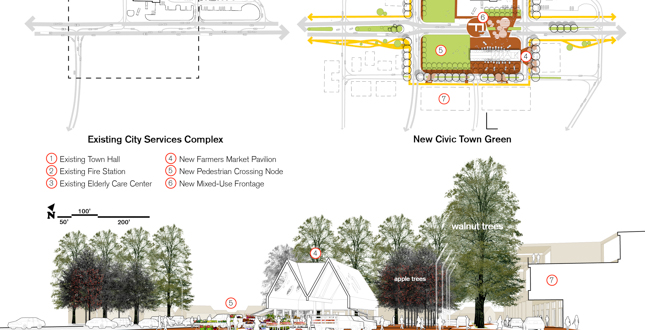 Close Me!
Close Me!Farmers' Market Pavilion and Town Green
Develop a year-round farmers' market to process regional food products, and to host multiple community events – Farmington's best porch.
Download Hi-Res ImageImage: University of Arkansas Community Design Center
Image 9 of 16
 Close Me!
Close Me!Riparian Bridge Gateway
Develop the intersection between highway and riparian greenway with agricultural urban components and new bridging elements. The eastern gateway serves as neighborhood threshold organizing scattered assets (i.e., buildings, bridges, parking lots, and streams) into a coherent, identifiable, urban realm.
Download Hi-Res ImageImage: University of Arkansas Community Design Center
Image 10 of 16
 Close Me!
Close Me!Farmington Gateways
Designed for food production and processing, the combined landscape and street system, serves as public armature ordering future infill development between the gateway.
Download Hi-Res ImageImage: University of Arkansas Community Design Center
Image 11 of 16
 Close Me!
Close Me!Phase 2
Focused on infill, phase two introduces new right-of-way geometries between gateways, including a food-bearing multiway boulevard that accommodates regional and local traffic with bicycle and pedestrian facilities. New pedestrian crossings and nodes connect the commercial sector with public school facilities across the corridor, creating a safer multi-modal realm.
Download Hi-Res ImageImage: University of Arkansas Community Design Center
Image 12 of 16
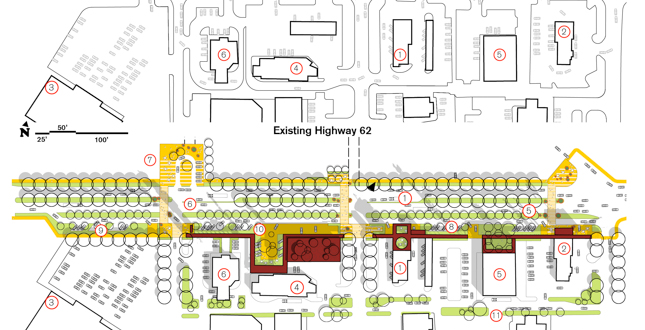 Close Me!
Close Me!New Food-Bearing Multiway Boulevard and Pedestrian Interface Plan
The multiway boulevard can accommodate existing land uses while developing a “food utility” that provides access to local food production and can be foraged. Retrofits also accommodate multiple modes of transit, including pedestrian, bicycle, and local as well as regional automobile traffic.
Download Hi-Res ImageImage: University of Arkansas Community Design Center
Image 13 of 16
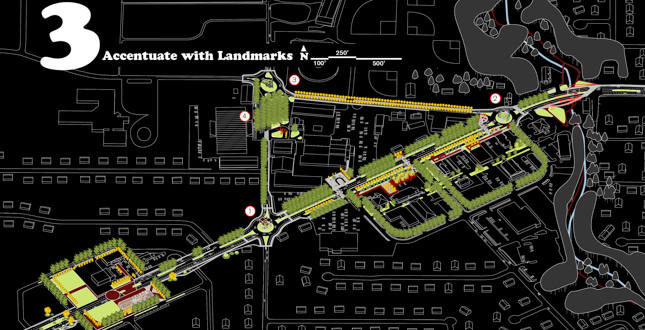 Close Me!
Close Me!Phase 3 Traffic calming (without diminishing throughput) is achieved through spatial definition and civic art in lieu of engineering devices.
Phase three substitutes roundabouts for traffic signaling at two key intersections within the corridor segment. roundabouts extend the gateway features and are accentuated with public art structures featuring signage and urban agricultural living walls.
Download Hi-Res ImageImage: University of Arkansas Community Design Center
Image 14 of 16
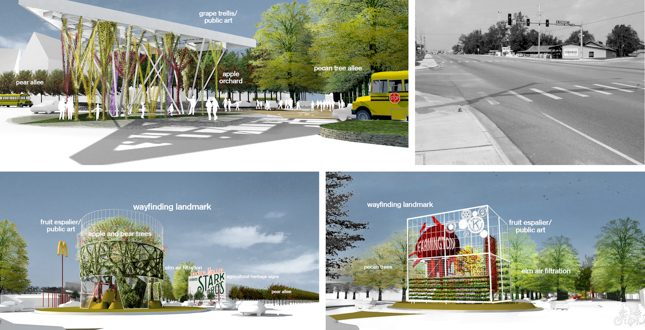 Close Me!
Close Me!Roundabouts as Public Art
Besides maintaining continuous traffic flow, roundabouts rationalize awkward and dangerous street intersections while enhancing street aesthetics with wayfinding landmarks that combine public art and urban agricultural espaliers. The roundabout with an accompanying plaza at the public school facilities connects sports facilities with academic buildings severed by the road.
Download Hi-Res ImageImage: University of Arkansas Community Design Center
Image 15 of 16
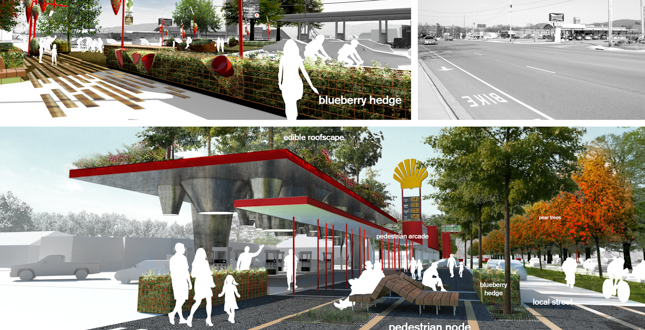 Close Me!
Close Me!Food-Bearing Multiway Boulevard and Pedestrian Interface
Coupled with a new “food utility”, ordinary street accessories related to lighting, signage, paving, shelter, and furniture civilize the corridor, creating a pedestrian-oriented frontage system that incents better use of the land.
Download Hi-Res ImageImage: University of Arkansas Community Design Center
Image 16 of 16
Project Statement
The Farmington townscape plan retrofits a suburban five-lane commercial arterial into a food-bearing multiway boulevard, revitalizing this once vibrant 5,000-person farming community. Townscaping employs a serial organization of nodes to create a walkable urban environment within an automobile-oriented context. Townscaping proposes an incremental urbanism without reliance on capital-intensive architectural investments. The goal is to evolve a memorable town fabric through three placemaking strategies: 1) agricultural urbanism, 2) context-sensitive highway design, and 3) public art planning.
Project Narrative
—2013 Professional Awards Jury
Farmington was once a substantial agricultural community in one of the country's largest apple-growing regions. It is estimated that 40 percent of the apples and pears grown at the turn of the 20th century were grown in Northwest Arkansas. The townscape plan proposes to re-restablish a local foodscape, recalling Farmington's agricultural heritage. The convenience provided by proximity to growing systems demystifies farming and positions it to be a tool for local economic development and jobs creation.
1. Develop an urban agricultural landscape network of civic food-bearing landscapes - edible landscapes - in public right-of-ways, recalling Farmington's lost agricultural heritage. This provides local food supply resiliency and security, while democratizing access to improved nutrition and healthy lifestyles. Landscapes include fruit-bearing arboretums, foraging landscapes, herbaceous container gardens, trellised vines, and espaliers ("plant training"). Urban landscapes are designed as laminated ecosystems since some plants are optionmal remediators of air and water pollution, while others favor nutrient cycling and soil husbandry or integrated pest management.
2. Provide a model context-sensitive highway design that enhances the delivery of ecological and urban services offered by SR 62. According to the Federal Highway Administration: "Context-sensitive solutions (CSS) is a collaborative, interdisciplinary approach that involves all stakeholders to develop a transportation facility that fits its physical setting and preserves scenic, aesthetic, historic and environmental resources, while maintaining safety and mobility." The plan transforms a highway into a boulevard, accomodating the town's schools and institutional and commercial sectors arrayed along the highway. A proposed local frontage system on the commercialized south edge encourages pedestrain activity.
3. Introduce public art planning to develop a wayfinding system through the expresive power of signage, building frontage, street furniture, lighting, sculpture, memorials, landscaping, and other urban accessories. Unique townscape sets produced from the recombination of ordinary elements lend structure and imageability without having to rely on buildings in the initial phases. The artistic function amplifies resourcefulness in these ordinary elements, avoiding the isolation of public art as its own discrete land use.
Environmental/Social Data and Methods of Analysis
Mapping alayses chronicle Farmington's changing urban morphology as a function of its population growth and changing livelihood over the last century. Farmington was once a substantial downtown agricultural processing center in one of hte country's largest apple-growing regions, dwarfing nearby towns in importance. Now, Farmington is a bedroom community to these nearby towns, which have retained their downtown cores. Sprawling automobile-oriented patterns - high-speed commercial corridors, subdivision farms, and automobile-based retail - are addressed through sprawl repair protocols in content-sensitive highway design and urban architecture. The area's agricultural legacy prompted research and development in smart urban agricultural interfaces to reclaim a lost literacy in agriculture.
Consideration of Options and Public Participation
The project team devised a "Highway Ecology Matrix" consisting of ordinary components deployed in highway development classified according to the ascending levels of service. An ideal townscaping tool for non-designers, this matrix facilitates customization of highway segments - content sensitive design - through amenity combinations created by participating citizens. Project planning, involving community charrettes and workshops with civic groups, the school district, and the regional planning authority, was sponsored through a planning grant from the National Endowment for the Arts in their 2010 Access to Artistic Excellence program.
Role of Design
Design thinking was used to frame both a solution to the problem of the "shapeless environment" and to devise a vocabulary or syntax toward an articulated solution in incremental urbanism. Design development shows how combinations from the Smart Urban Argicultural Interfaces and Highway Ecology Matrix offer multiple corridor redevelopment solutions.
Project Implementation
Planning results are being used to seek 2013 Transportation Facilities Enhancement funding from Arkansas Highway Transportation Department (AHTD) to implement Phase 1, including improvements to the riparian corridor. Farmington is currently in discussions with property owners abutting the highway to acquire property for development of the town center.
Project Administration
The Farmington City Manager, assisted by planning staff from the Northwest Arkansas Regional Planning Commision, will be charged with executing the proposal, particulary in working with the Arkansas Highway and Transportation Department to implement context-sensitive highway practices. Local citizen clubs are fundraising to implement non-highway portions of the townscape.
Project Resources
Lead Designer
University of Arkansas Community Design Center (UACDC)
Landscape Architect of Record
Christopher Suneson, ASLA
UACDC Staff
Stephen Luoni, Director, Assoc. AIA
Jeffrey Huber, Assistant Director, AIA, LEED AP, NCARB
Cory Amos, Project Designer
Peter Bednar, Project Designer
Katie Breshears, Project Designer, AIA, LEED AP
Linda Komlos, Administrative Specialist
UACDC Students
Tyler K. Cukar
Caleb J. Lowery
Nicholas J. Pierce
Rebecca Roark
Sponsor
National Endowment for the Arts




